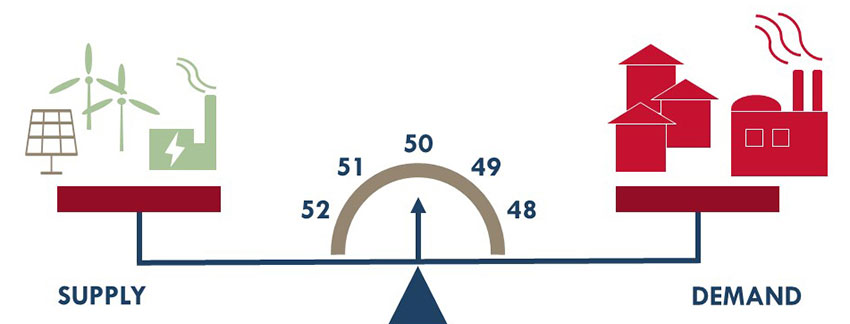In a research commissioned by CS Energy, Intelligent Energy Systems has explored a market mechanism to incentivise and reward faster frequency control services in the National Electricity Market (NEM).
Why is frequency important?
Maintaining electrical frequency consistently around 50 Hz is essential for the stability of power grids in large parts of the world.

Above: Frequency is about keeping electricity supply and demand in balance. (Graphic by AEMO).
In Australia, the NEM operates at a frequency range as close to 50 Hertz (Hz) as possible and it is the job of the Australian Energy Market Operator (AEMO) to keep frequency within a specified range referred to as the normal operating frequency band (49.85 Hz – 50.15 Hz).
If a large disturbance occurs on the grid, the frequency may deviate outside the safe range – for example if there is a sudden oversupply or undersupply of electricity. Uncontrolled changes in the magnitude and rate of change of frequency can result in widespread blackouts.
AEMO operates a Frequency Control Ancillary Services Market (FCAS) where market participants such as CS Energy are enabled to provide more or less power to correct any imbalances.
Frequency as the grid transitions
Over the last decade, both AEMO and the AEMC have written about a decline in the NEM’s frequency performance as Australia’s energy generation mix has changed.
In a recent change to the National Electricity Rules, the AEMC mandated the provision of primary frequency response to address the immediate need for improved frequency control in the NEM.
A three-year sunset period was included in the rule change to allow for the development of a market based mechanism to incentivise the provision of primary frequency control.
Intelligent Energy Systems’ research
CS Energy sponsored the research by Intelligent Energy Systems (IES) because it recognised the importance of a future market mechanism to value primary frequency response services.
IES proposes a double-sided causer pays concept, which involves compensating the providers of frequency response for their costs and levying the cost of the frequency response on those market participants who cause the frequency deviations.
Learn more about IES’s research at www.iesys.com/assets/news/attachments/IES-Insider-38.pdf